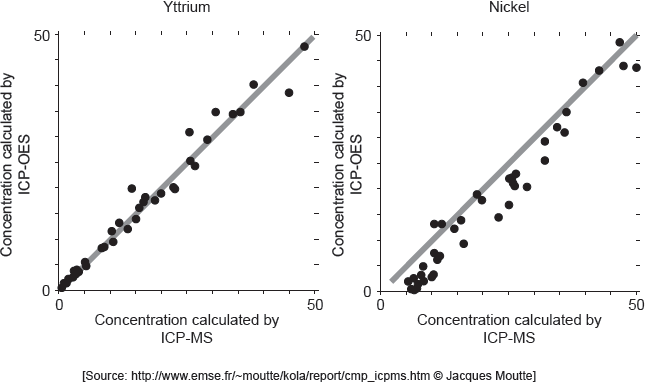| Date | May 2019 | Marks available | 3 | Reference code | 19M.3.sl.TZ2.4 |
| Level | SL | Paper | 3 | Time zone | TZ2 |
| Command term | Determine | Question number | 4 | Adapted from | N/A |
Question
Metals are extracted from their ores by several methods, including electrolysis and reduction with carbon.
Determine the mass of aluminium, in g, that could be extracted from an appropriate solution by a charge of 48250 C. Use sections 2 and 6 of the data booklet.
Once extracted, the purity of the metal can be assessed using ICP-MS. Suggest two advantages of using plasma technology rather than regular mass spectrometry.
Explain the action of metals as heterogeneous catalysts.
Outline how alloys conduct electricity and why they are often harder than pure metals.
Conduct electricity:
Harder than pure metals:
Carbon nanotubes are added to metals to increase tensile strength.
Write an equation for the formation of carbon nanotubes from carbon monoxide.
Markscheme
moles of electrons «= » = 0.5000 «mol» [✔]
moles of aluminium «= » = 0.1667 «mol» [✔]
mass of aluminium «= 26.98 g mol–1 × 0.1667mol» = 4.50 «g» [✔]
Note: Award [3] for correct final answer.
Any two of:
larger linear calibration [✔]
«accurate» detection of multiple elements/metals [✔]
«accurate» detection of elements in low concentration [✔]
temperature around 10000 K atomises/ionises every material [✔]
Any two of:
reactant(s) adsorb onto active sites/surface [✔]
bonds weakened/broken/stretched «in adsorbed reactants»
OR
activation energy lowered [✔]
products desorbed [✔]
Note: Accept “products released” for M3.
Conduct electricity:
«delocalized/valence» electrons free to move «under potential difference» [✔]
Harder than pure metals:
atoms/ions of different sizes prevent layers «of atoms/ions» from sliding over one another [✔]
2CO(g) → C(s) + CO2 (g) [✔]
Examiners report
Many students scored at least one point typically the 1st mark with many obtaining the 2nd and 3rd marks as well. If students struggled it was typically with the second mark where the number of electrons was required.
This was question was not answered well. Most candidates did not seem to understand any advantages of ICP-MS or how to describe them.
This question was reasonably answered with many candidates receiving a mark for the action of a catalyst. Teachers should remind students to use the terms adsorb/desorb with this type of process, not absorb.
Most candidates were awarded M1 for how alloys conduct electricity. Some struggled with describing why they are harder than pure metals. Teachers should remind student to use proper terminology such as atoms or ions not nuclei for this type of answer.
This was a very poorly answered question. Very few candidates knew the correct balanced equation or gave an equation that was not balanced.


